New Zealand volcano: Five dead and eight missing after eruption
- Published
Tourists could be seen waiting to be evacuated from White Island
New Zealand police have confirmed that five people have died and eight are missing after White Island volcano erupted on Monday as tourists visited.
Thirty-four people survived, with 31 still receiving treatment in hospital.
Two British women were among those receiving treatment, said the UK High Commissioner to New Zealand, Laura Clarke.
Australian Prime Minister Scott Morrison said he "feared" three of the five confirmed dead were Australian.
Mr Morrison said that 24 Australians were on board a cruise ship exploring the island in the Bay of Plenty when the volcano erupted. Of those, 13 people had been hospitalised and 11 were unaccounted for, he said.
"This is a terrible tragedy, a time of great innocence and joy interrupted by the horror of that eruption," Mr Morrison told reporters in Sydney.
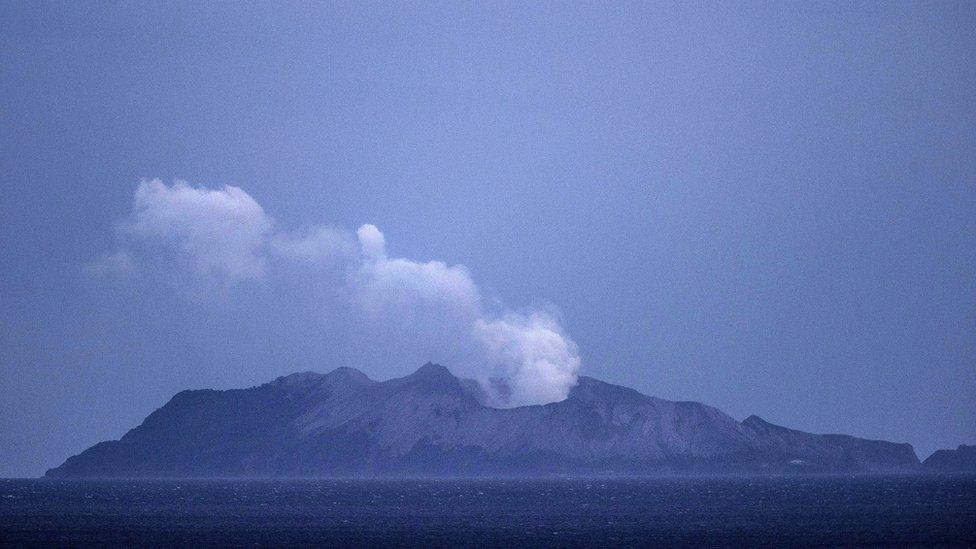
The volcano early on Tuesday
Also among those listed as missing or injured were US, Chinese, Malaysian and New Zealand citizens.
New Zealand Prime Minister Jacinda Ardern said at a press conference on Tuesday that she shared the "unfathomable grief" of those who had lost loved ones.
Tourists were seen walking inside the crater of White Island volcano moments before it erupted. Ms Ardern said further rescue efforts for the missing were now "very sadly a recovery operation".
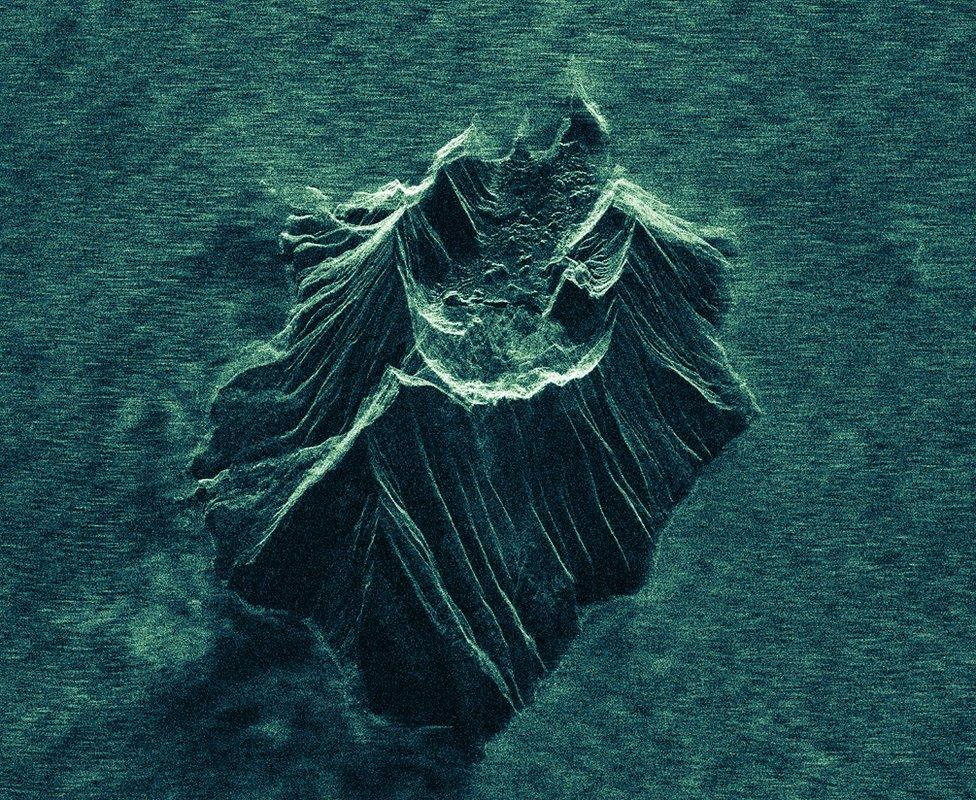
This satellite radar image shows White Island volcano after the eruption - radar is able to take images that are not obscured by ash, steam and cloud
The survivors of the eruption were taken off the uninhabited island by boat or by helicopter. Emergency services have so far been unable to search the area because of dangerous conditions, with plumes of smoke and ash continuing to rise above the volcano on Tuesday.
Ms Ardern acknowledged the apparently high number of Australian victims. "Can I say to our Australian family, there are no two countries closer and we are devastated at what has happened here and particularly want to acknowledge those from Australia who have been caught up in this horrific, horrific incident," she said.
White Island, also called Whakaari, is the country's most active volcano. Despite that, the privately owned island is a tourist destination with frequent day tours and scenic flights available.

'Hard to fathom how this happened'
Simon Atkinson, BBC News, Whakatane
At sunrise in Whakatane, smoke could be seen rising from White Island or Whakaari - 50km across the ocean.
The waterfront was eerily quiet - save for the Australian and New Zealand TV networks (along with the BBC) sombrely conveying the latest updates on the dead, the missing and the injured.
None of those hurt remain in the local hospital which was a hive of activity less than 24 hours earlier.
Three patients have been discharged. Others - too sick for this small town facility - have been sent to specialist burns departments across the country. Many of them are critically ill.
Earlier, as we drove to Whakatane through the night from Auckland we passed the illuminated outline of the Ovation of the Seas - the cruise ship which should have been continuing its tour around New Zealand.
Instead it remains moored, as its passengers - some of them the friends and families of those hurt, killed and missing - try to fathom how this happened.

Rescuers wait for safety to approach
Police confirmed that a total of 47 people had been on the island when the disaster happened on Monday afternoon local time.
Rescuers will only go to the island when it is safe to do so, said Superintendent Bruce Bird. But reconnaissance flights detected no signs of life there.
"We will be relying on advice coming from the scientific and technical committee in Wellington who are currently meeting at the moment and hope to hear further advice on when we may potentially return to the island," Supt Bird said.
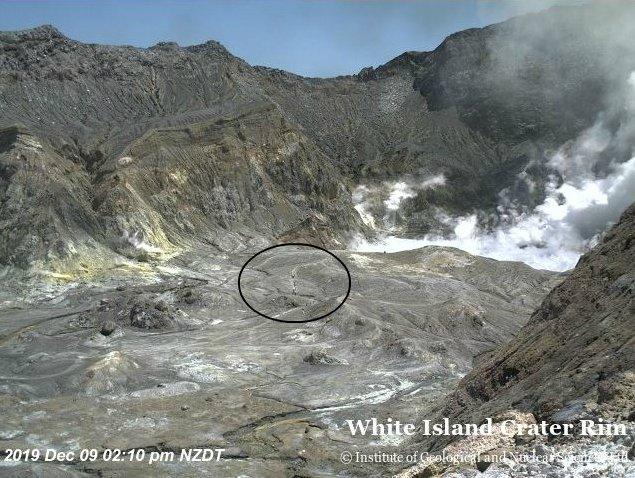
A group of visitors (circled) could be seen inside the crater before images went dark

Speaking at the same news conference, Prime Minister Ardern paid tribute to helicopter crews who had flown to the island on Monday to bring people out despite the dangers.
"I want to acknowledge the courageous decision made by first responders and those pilots who in their immediate rescue efforts made an incredibly brave decision under extraordinarily dangerous circumstances in an attempt to get people out," she said.
What happened at the volcano?
White Island erupted at around 14:11 (01:11 GMT) on Monday, sending up a thick plume of ash and smoke which was filmed by visitor Michael Schade.
Mr Schade, who was on a boat leaving the island after a morning tour, told the BBC he had been at the crater just 30 minutes before the disaster.
Allow X content?
This article contains content provided by X. We ask for your permission before anything is loaded, as they may be using cookies and other technologies. You may want to read X’s cookie policy, external and privacy policy, external before accepting. To view this content choose ‘accept and continue’.

"We had just got on the boat... then someone pointed it out and we saw it," he said.
"I was basically just shocked. The boat turned back and we grabbed some people that were waiting on the pier."
Another witness, Brazilian Allessandro Kauffmann, said in an Instagram post in Portuguese, external that his boat had left five minutes before the eruption.
"This other tour that arrived right after, unfortunately they did not manage to leave in time, and there were some people that suffered serious burns," he added.
A live feed from the volcano showed a group of visitors inside the crater before the stream went dark.
Who was caught up in the disaster?
There are few details about those caught in the eruption. Some who had gone to the island were passengers from the Ovation of the Seas, a cruise ship owned by Royal Caribbean.
It left Sydney last week and stopped near Auckland on New Zealand's North Island before arriving in the city of Tauranga, near White Island, on Sunday.
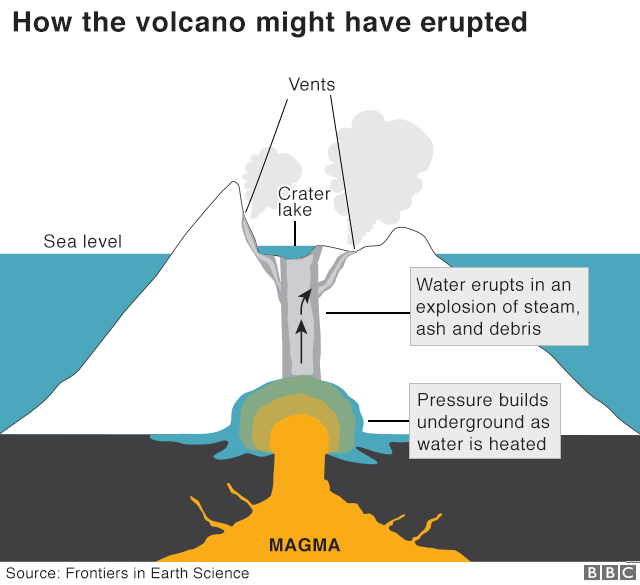

Australian Prime Minister Scott Morrison said Australians had "been caught up in this terrible event" and the authorities were "working to determine their wellbeing".
Why are tourists allowed on the island?
The island, also known as Whakaari, is privately owned and is typically visited by thousands of tourists every year, despite the fact that it has been erupting in some form since 2011.
Geological hazard monitors GeoNet pass on information about the volcano's activity to tour operators and the police, but tourists make their own decisions about whether to visit.
Visitors are supplied with hard hats and gas masks, external to protect against sulphurous steam and must have suitable footwear to make the tour, according to New Zealand website Stuff.
The owners of Whakatane-based company White Island Tours are the official guardians of the island, which was declared a private scenic reserve in 1952, and they grant access through designated tour operators.
According to the New Zealand Herald, White Island Tours warned on its website that visitors "should be aware that there is always a risk of eruptive activity regardless of the alert level", while stating it followed a "comprehensive safety plan which determines" its activities on the island "at the various levels".
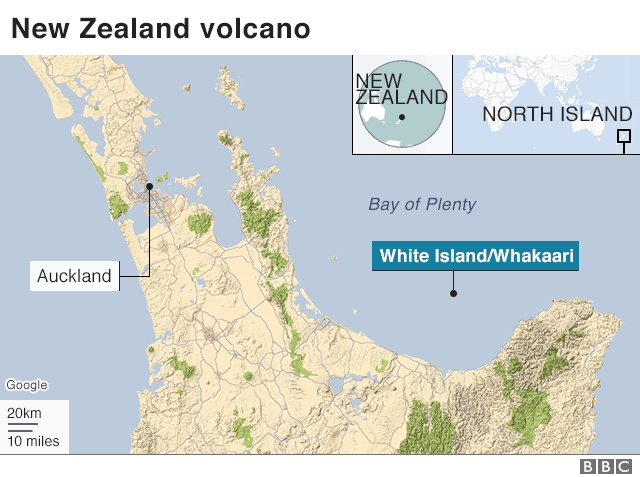

Company chairman Paul Quinn said the event on the island had been a "terrible tragedy" and the company's "thoughts and prayers are with everyone who has been impacted".
The BBC has contacted White Island Tours for comment.
Last Tuesday GeoNet warned of a heightened level of activity at the site, but also said that "the current level of activity does not pose a direct hazard to visitors".
White Island has seen several eruptions over the years, most recently in 2016 but no-one was hurt in that event.



- Published9 December 2019
